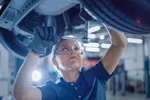There are two separate areas of the commercial vehicle market which are currently enjoying strong growth, but could well have difficulty when it comes to the issue of future residual values.
The Government's desire to expand the use of LPG powered vehicles, especially vans, is well documented. We all know the benefits for the environment, and for the first-life operator in terms of Powershift grants and reduced fuel duty. Indeed without these incentives, LPG powered vehicles are not viable when compared to modern diesels.
There are, however, areas of concern that may hinder expansion. Firstly, if demand for alternatively fuelled vehicles accelerates rapidly there is a real possibility of the Powershift budget being exhausted before the end of the current three-year period.
Secondly, and more importantly, there is significant resistance in the used van market to LPG-powered vehicles.
Many new LPG vans are used in urban environments on multi-drop stop-start operations that are hard on engines, transmissions and brakes. In addition, the used market favours the durability, driveability and economy of modern common-rail diesels.
Used van buyers tend to have lower operating budgets and are often unwilling to pay the high labour rates associated with franchised networks, preferring to have maintenance carried out by local independents. These are likely to have little or no experience of LPG vehicles.
This factor, combined with the fact that most LPG vans have the fuel storage tank in the load compartment, reducing volume, limits their desirability. This is reflected in lower residual values.
The commercial vehicle market is enjoying strong sales, despite a 3.8% fall in July. The 3,501-7,400kg sector rose 22% , according to SMMT figures.
The reason for this is the rapid expansion of internet shopping and the home delivery market.
Multi-compartment temperature controlled bodies make the vehicle kerb weights such that a gross weight of at least four tonnes is required. These vehicles are ideally suited to their purpose, offering good payload, fuel efficiency and manoeuvrability while appearing no larger than a 3.5-tonne vehicle.
However, these vehicles, like LPG vans, suffer a lack of secondhand desirability. A multi-compartment fridge box is of no use for any other purpose – as such, their residual values are forecast to be little more than those of used dry freight boxes.
As the new driving licence regulations take effect, this size of vehicle may become more popular. However it is the standard dropside, box or tipper versions that will benefit while those with non-standard bodywork will still suffer.















Login to comment
Comments
No comments have been made yet.